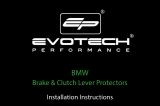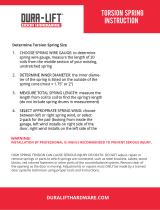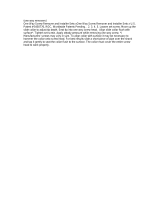Page is loading ...

PRINTED IN JAPAN
2010.05—0.8 × 1 !
(E)
YAMAHA MOTOR CO., LTD.
2500 SHINGAI IWATA SHIZUOKA JAPAN
PRINTED ON RECYCLED PAPER
PROTECT YOUR INVESTMENT
Use
Genuine YAMAHA
Parts And Accessories
YZ450FA
2011
OWNER’S SERVICE MANUAL
YZ450FA
33D-28199-11
LIT-11626-24-22
2011
q Read this manual carefully before operating this vehicle.

Q
Read this manual carefully before operating this vehicle. This manual should stay with this vehicle if it is sold.

YZ450FA
OWNER'S SERVICE MANUAL
©2010 by Yamaha Motor Corporation, U.S.A.
1st Edition, May 2010
All rights reserved.
Any reprinting or unauthorized use
without the written permission of
Yamaha Motor Corporation, U.S.A.
is expressly prohibited.
Printed in Japan
P/N. LIT-11626-24-22

INTRODUCTION
Congratulations on your purchase of a Yamaha
YZ series. This model is the culmination of Ya-
maha's vast experience in the production of
pacesetting racing machines. It represents the
highest grade of craftsmanship and reliability
that have made Yamaha a leader.
This manual explains operation, inspection, ba-
sic maintenance and tuning of your machine. If
you have any questions about this manual or
your machine, please contact your Yamaha
dealer.
Yamaha continually seeks advancements in
product design and quality. Therefore, while
this manual contains the most current product
information available at the time of printing,
there may be minor discrepancies between
your machine and this manual. If you have any
questions concerning this manual, please con-
sult your Yamaha dealer.
PLEASE READ THIS MANUAL CAREFULLY
AND COMPLETELY BEFORE OPERATING
THIS MACHINE. DO NOT ATTEMPT TO OP-
ERATE THIS MACHINE UNTIL YOU HAVE
ATTAINED A SATISFACTORY KNOWL-
EDGE OF ITS CONTROLS AND OPERATING
FEATURES AND UNTIL YOU HAVE BEEN
TRAINED IN SAFE AND PROPER RIDING
TECHNIQUES. REGULAR INSPECTIONS
AND CAREFUL MAINTENANCE, ALONG
WITH GOOD RIDING SKILLS, WILL ENSURE
THAT YOU SAFETY ENJOY THE CAPABILI-
TIES AND THE RELIABILITY OF THIS MA-
CHINE.
IMPORTANT MANUAL
INFORMATION
Particularly important information is distin-
guished in this manual by the following nota-
tions.
This is the safety alert symbol. It is used to
alert you to potential personal injury haz-
ards. Obey all safety messages that follow
this symbol to avoid possible injury or
death.
A WARNING indicates a hazardous situa-
tion which, if not avoided, could result in
death or serious injury.
A NOTICE indicates special precautions
that must be taken to avoid damage to the
vehicle or other property.
A TIP provides key information to make proce-
dures easier or clearer.

SAFETY INFORMATION
THIS MACHINE IS DESIGNED STRICTLY
FOR COMPETITION USE, ONLY ON A
CLOSED COURSE. It is illegal for this machine
to be operated on any public street, road, or
highway. Off-road use on public lands may also
be illegal. Please check local regulations be-
fore riding.
• THIS MACHINE IS TO BE OPERATED BY
AN EXPERIENCED RIDER ONLY.
Do not attempt to operate this machine at
maximum power until you are totally familiar
with its characteristics.
• THIS MACHINE IS DESIGNED TO BE RID-
DEN BY THE OPERATOR ONLY.
Do not carry passengers on this machine.
• ALWAYS WEAR PROTECTIVE APPAREL.
When operating this machine, always wear an
approved helmet with goggles or a face
shield. Also wear heavy boots, gloves, and
protective clothing. Always wear proper fitting
clothing that will not be caught in any of the
moving parts or controls of the machine.
• ALWAYS MAINTAIN YOUR MACHINE IN
PROPER WORKING ORDER.
For safety and reliability, the machine must be
properly maintained. Always perform the pre-
operation checks indicated in this manual.
Correcting a mechanical problem before you
ride may prevent an accident.
• GASOLINE IS HIGHLY FLAMMABLE.
Always turn off the engine while refueling.
Take care to not spill any gasoline on the en-
gine or exhaust system. Never refuel in the vi-
cinity of an open flame, or while smoking.
• GASOLINE CAN CAUSE INJURY.
If you should swallow some gasoline, inhale
excess gasoline vapors, or allow any gasoline
to get into your eyes, contact a doctor imme-
diately. If any gasoline spills onto your skin or
clothing, immediately wash skin areas with
soap and water, and change your clothes.
• ONLY OPERATE THE MACHINE IN AN
AREA WITH ADEQUATE VENTILATION.
Never start the engine or let it run for any
length of time in an enclosed area. Exhaust
fumes are poisonous. These fumes contain
carbon monoxide, which by itself is odorless
and colorless. Carbon monoxide is a danger-
ous gas which can cause unconsciousness or
can be lethal.
• PARK THE MACHINE CAREFULLY; TURN
OFF THE ENGINE.
Always turn off the engine if you are going to
leave the machine. Do not park the machine
on a slope or soft ground as it may fall over.
• THE ENGINE, EXHAUST PIPE, MUFFLER,
AND OIL TANK WILL BE VERY HOT AFTER
THE ENGINE HAS BEEN RUN.
Be careful not to touch them or to allow any
clothing item to contact them during inspec-
tion or repair.
• PROPERLY SECURE THE MACHINE BE-
FORE TRANSPORTING IT.
For safety, drain the gasoline from the fuel
tank before transporting the vehicle.

YAMAHA MOTOR CORPORATION, U.S.A.
YZ MOTORCYCLE LIMITED WARRANTY

HOW TO USE THIS MANUAL
FINDING THE REQUIRED PAGE
1. This manual consists of eight chapters; "General Information", "Specifications", "Regular inspec-
tion and adjustments", "Engine", "Chassis", "Fuel system", "Electrical" and "Tuning".
2. The table of contents is at the beginning of the manual. Look over the general layout of the book
before finding then required chapter and item.
Bend the book at its edge, as shown, to find the required fore edge symbol mark and go to a page
for required item and description.
MANUAL FORMAT
All of the procedures in this manual are organized in a sequential, step-by-step format. The informa-
tion has been complied to provide the mechanic with an easy to read, handy reference that contains
comprehensive explanations of all disassembly, repair, assembly, and inspection operations.
In this revised format, the condition of a faulty component will precede an arrow symbol and the
course of action required will follow the symbol, e.g.,
• Bearings
Pitting/damage → Replace.

HOW TO READ DESCRIPTIONS
To help identify parts and clarify procedure steps, there are exploded diagrams at the start of each
removal and disassembly section.
1. An easy-to-see exploded diagram "1" is provided for removal and disassembly jobs.
2. Numbers "2" are given in the order of the jobs in the exploded diagram. A number that is enclosed
by a circle indicates a disassembly step.
3. An explanation of jobs and notes is presented in an easy-to-read way by the use of symbol marks
"3". The meanings of the symbol marks are given on the next page.
4. A job instruction chart "4" accompanies the exploded diagram, providing the order of jobs, names
of parts, notes in jobs, etc.
5. For jobs requiring more information, the step-by-step format supplements "5" are given in addition
to the exploded diagram and job instruction chart.

ILLUSTRATED SYMBOLS (Refer
to the illustration)
Illustrated symbols "1" to "7" are used to identi-
fy the specifications appearing in the text.
1. With engine mounted
2. Filling fluid
3. Lubricant
4. Special tool
5. Tightening
6. Specified value, Service limit
7. Resistance (Ω), Voltage (V), Electric cur-
rent (A)
Illustrated symbols "8" to "13" in the exploded
diagrams indicate grade of lubricant and loca-
tion of lubrication point.
8. Apply engine oil
9. Apply molybdenum disulfide oil
10. Apply brake fluid
11. Apply lightweight lithium-soap base grease
12. Apply molybdenum disulfide grease
13. Apply silicone grease
Illustrated symbols "14" to "15" in the exploded
diagrams indicate where to apply a locking
agent and where to install new parts.
14. Apply locking agent (LOCTITE
®
)
15. Use new one

MEMO

TABLE OF CONTENTS
GENERAL INFORMATION
1
SPECIFICATIONS
2
REGULAR INSPECTION AND
ADJUSTMENTS
3
ENGINE
4
CHASSIS
5
FUEL SYSTEM
6
ELECTRICAL
7
TUNING
8

CONTENTS
CHAPTER 1
GENERAL INFORMATION
LOCATION OF IMPORTANT LABELS ..... 1-1
DESCRIPTION ........................................... 1-2
CONSUMER INFORMATION .................... 1-3
FEATURES ................................................ 1-4
INCLUDED PARTS.................................... 1-6
IMPORTANT INFORMATION.................... 1-8
HANDLING THE ELECTRONIC
PARTS ..................................................... 1-10
CHECKING OF CONNECTION ............... 1-10
SPECIAL TOOLS..................................... 1-12
CONTROL FUNCTIONS.......................... 1-17
STARTING AND BREAK-IN.................... 1-19
TORQUE-CHECK POINTS...................... 1-21
CLEANING AND STORAGE ................... 1-22
CHAPTER 2
SPECIFICATIONS
GENERAL SPECIFICATIONS................... 2-1
MAINTENANCE SPECIFICATIONS.......... 2-4
TIGHTENING TORQUES......................... 2-13
LUBRICATION DIAGRAMS .................... 2-21
CABLE ROUTING DIAGRAM.................. 2-23

CHAPTER 3
REGULAR INSPECTION AND
ADJUSTMENTS
MAINTENANCE INTERVALS.................... 3-1
PRE-OPERATION INSPECTION AND
MAINTENANCE ......................................... 3-6
ENGINE...................................................... 3-7
CHASSIS.................................................. 3-20
ELECTRICAL........................................... 3-37
TROUBLESHOOTING ............................. 3-39
CHAPTER 4
ENGINE
SEAT AND SIDE COVERS........................ 4-1
EXHAUST PIPE AND SILENCER ............. 4-3
RADIATOR................................................. 4-8
CAMSHAFTS ........................................... 4-12
CYLINDER HEAD .................................... 4-19
VALVES AND VALVE SPRINGS ............ 4-23
CYLINDER AND PISTON ........................ 4-30
CLUTCH................................................... 4-35
OIL FILTER ELEMENT AND
WATER PUMP ......................................... 4-41
BALANCER ............................................. 4-47
OIL PUMP ................................................ 4-51
KICK SHAFT AND SHIFT SHAFT........... 4-55
AC MAGNETO ......................................... 4-62
ENGINE REMOVAL................................. 4-65
CRANKCASE AND CRANKSHAFT........ 4-71
TRANSMISSION, SHIFT CAM AND
SHIFT FORK ............................................ 4-79

CHAPTER 5
CHASSIS
FRONT WHEEL AND REAR WHEEL ....... 5-2
FRONT BRAKE AND REAR BRAKE........ 5-9
FRONT FORK .......................................... 5-23
HANDLEBAR........................................... 5-36
STEERING ............................................... 5-42
SWINGARM ............................................. 5-47
REAR SHOCK ABSORBER.................... 5-54
CHAPTER 6
FUEL SYSTEM
FUEL TANK ............................................... 6-2
THROTTLE BODY ..................................... 6-6
CHAPTER 7
ELECTRICAL
ELECTRICAL COMPONENTS AND
WIRING DIAGRAM .................................... 7-1
IGNITION SYSTEM.................................... 7-4
THROTTLE POSITION
SENSOR SYSTEM..................................... 7-8
FUEL INJECTION SYSTEM .................... 7-11
FUEL PUMP SYSTEM ............................. 7-44
ELECTRICAL COMPONENTS ................ 7-45
CHAPTER 8
TUNING
CHASSIS.................................................... 8-1

1-1
LOCATION OF IMPORTANT LABELS
GENERAL INFORMATION
LOCATION OF IMPORTANT LABELS
Please read the following important labels carefully before operating this vehicle.
Premium unleaded
gasoline only.
3FB-2415E-02
4AA-22259-80
WARNING
This unit contains high pressure nitrogen gas.
Mishandling can cause explosion.
Read owner’s manual for instructions.
Do not incinerate, puncture or open.
17D-2812P-00
For use only on a closed course
in sanctioned competition.
This motorcycle does not meet
EPA noise and emissions
standards and is not for general
off-road recreational riding.
1

1-2
DESCRIPTION
DESCRIPTION
• The machine you have purchased may differ slightly from those shown in the following.
• Designs and specifications are subject to change without notice.
1. Clutch lever
2. Front brake lever
3. Throttle grip
4. Radiator cap
5. Fuel tank cap
6. Engine stop switch
7. Kickstarter crank
8. Fuel tank
9. Radiator
10. Coolant drain bolt
11. Rear brake pedal
12. Valve joint
13. Air cleaner
14. Drive chain
15. Shift pedal
16. Oil level check window
17. Starter knob/idle screw
18. Front fork

1-3
CONSUMER INFORMATION
CONSUMER INFORMATION
There are two significant reasons for knowing
the serial number of your machine:
1. When ordering parts, you can give the num-
ber to your Yamaha dealer for positive iden-
tification of the model you own.
2. If your machine is stolen, the authorities will
need the number to search for and identify
your machine.
VEHICLE IDENTIFICATION NUMBER
The vehicle identification number "1" is
stamped on the right of the steering head pipe.
ENGINE SERIAL NUMBER
The engine serial number "1" is stamped into
the elevated part of the right-side of the engine.
MODEL LABEL
The model label "1" is affixed to the frame un-
der the rider's seat. This information will be
needed to order spare parts.

1-4
FEATURES
FEATURES
OUTLINE OF THE FI SYSTEM
The main function of a fuel supply system is to provide fuel to the combustion chamber at the opti-
mum air-fuel ratio in accordance with the engine operating conditions and the atmospheric tempera-
ture.Inthe conventional carburetor system, the air-fuel ratio of the mixture that is supplied to the
combustionchamber is created by the volume of the intake air and the fuel that is metered by the jet
used in the respective carburetor.
Despite the same volume of intake air, the fuel volume requirement varies by the engine operating
conditions,such as acceleration, deceleration, or operating under a heavy load.Carburetors that me-
ter the fuel through the use of jets have been provided with various auxiliary devices, so that an op-
timum air fuel ratio can be achieved to accommodate the constant changes in the operating
conditions of the engine.
This model has adopted an electronically controlled fuel injection (FI) system, in place of the conven-
tional carburetor system.This system can achieve an optimum air-fuel ratio required by the engine at
all times by using a microprocessor that regulates the fuel injection volume according to the engine
operating conditions detected by various sensors.
1. Fuel injector
2. Throttle position sensor
3. Intake air pressure sensor
4. ECU
5. Fuel pump
6. Intake air temperature sensor
7. Atmospheric pressure sensor
8. Crankshaft position sensor
9. Coolant temperature sensor
10. Ignition coil
11. Condenser

1-5
FEATURES
FI SYSTEM
The fuel pump delivers fuel to the fuel injector via the fuel filter. The pressure regulator maintains the
fuel pressure that is applied to the fuel injector at only 324 kPa (3.24 kgf/cm ² , 47.0 psi). According-
ly,when the energizing signal from the ECU energizes the fuel injector, the fuel passage opens, caus-
ing the fuel to be injected into the intake manifold only during the time the passage remains open.
Therefore, the longer the length of time the fuel injector is energized (injection duration), the greater
the volume of fuel that is supplied. Conversely, the shorter the length of time the fuel injector is en-
ergized(injection duration), the lesser the volume of fuel that is supplied.
The injection duration and the injection timing are controlled by the ECU. Signals that are input from
the throttle position sensor, coolant temperature sensor, atmospheric pressure sensor, lean angle
sensor, crankshaft position sensor, intake air pressure sensor and intake air temperature sensor en-
able the ECU to determine the injection duration. The injection timing is determined through the sig-
nals from the rankshaft position sensor. As a result, the volume of fuel that is required by the engine
can be supplied at all times in accordance with the driving conditions.
1. Fuel pump
2. Fuel injector
3. ECU
4. Throttle position sensor
5. Coolant temperature sensor
6. Crankshaft position sensor
7. Intake air pressure sensor
8. Throttle body
9. Intake air temperature sensor
10. Air filter case
11. Atmospheric pressure sensor
A. Fuel system
B. Intake system
C. Control system
1
10
9
B
8
7
6
5
A
2
3
C
4
11

1-6
INCLUDED PARTS
INCLUDED PARTS
DETACHABLE SIDESTAND
This sidestand "1" is used to support only the
machine when standing or transporting it.
• Never apply additional force to the side-
stand.
• Remove this sidestand before starting out.
VALVE JOINT
This valve joint "1" prevents fuel from flowing
out and is installed to the fuel tank breather
hose.
In this installation, make sure the arrow fac-
es the fuel tank and also downward.
SPARK PLUG WRENCH
This spark plug wrench "1" is used to remove
and install the spark plug.
NIPPLE WRENCH
This nipple wrench "1" is used to tighten the
spoke.
HANDLEBAR PROTECTOR
Install the handlebar protector "1" so that the
mark "a" face forward.
FUEL TANK HOLDING CABLE
The fuel tank holding cable "1" is used to sup-
port the fuel tank during maintenance.
/



